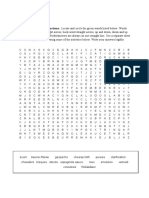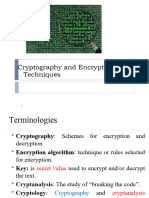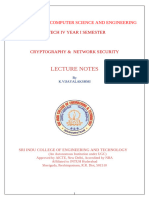Foundations of Computer Security: Lecture 40: Substitution Ciphers
Uploaded by
Mc Robinson ReguceraFoundations of Computer Security: Lecture 40: Substitution Ciphers
Uploaded by
Mc Robinson ReguceraFoundations of Computer Security
Lecture 40: Substitution Ciphers
Dr. Bill Young
Department of Computer Sciences
University of Texas at Austin
Lecture 40: 1 Substitution Ciphers
Substitution Ciphers
A substitution cipher is one in which each symbol of the plaintext
is exchanged for another symbol.
If this is done uniformly this is called a monoalphabetic cipher or
simple substitution cipher.
If different substitutions are made depending on where in the
plaintext the symbol occurs, this is called a polyalphabetic
substitution.
Lecture 40: 2 Substitution Ciphers
Simple Substitution
A simple substitution cipher is an injection (1-1 mapping) of the
alphabet into itself or another alphabet. What is the key?
A simple substitution is breakable; we could try all k! mappings
from the plaintext to ciphertext alphabets. That’s usually not
necessary.
Redundancies in the plaintext (letter frequencies, digrams, etc.)
are reflected in the ciphertext.
Not all substitution ciphers are simple substitution ciphers.
Lecture 40: 3 Substitution Ciphers
Caesar Cipher
The Caesar Cipher is a monoalphabetic cipher in which each letter
is replaced in the encryption by another letter a fixed “distance”
away in the alphabet.
For example, A is replaced by C, B by D, ..., Y by A, Z by B, etc.
What is the key?
What is the size of the keyspace? Is the algorithm strong?
Lecture 40: 4 Substitution Ciphers
Vigenère Cipher
The Vigenère Cipher is an example of a polyalphabetic cipher,
sometimes called a running key cipher because the key is another
text.
Start with a key string: “monitors to go to the bathroom” and a
plaintext to encrypt: “four score and seven years ago.” Align the
two texts, possibly removing spaces:
plaintext: fours corea ndsev enyea rsago
key: monit orsto gotot hebat hroom
ciphertext: rcizl qfkxo trlso lrzet yjoua
Then use the letter pairs to look up an encryption in a table
(called a Vigenère Tableau or tabula recta).
What is the corresponding decryption algorithm?
Lecture 40: 5 Substitution Ciphers
Vigenère Tableau
A B C D E F G H I J K L M N O P Q R S T U V W X Y Z
A A B C D E F G H I J K L M N O P Q R S T U V W X Y Z
B B C D E F G H I J K L M N O P Q R S T U V W X Y Z A
C C D E F G H I J K L M N O P Q R S T U V W X Y Z A B
D D E F G H I J K L M N O P Q R S T U V W X Y Z A B C
E E F G H I J K L M N O P Q R S T U V W X Y Z A B C D
F F G H I J K L M N O P Q R S T U V W X Y Z A B C D E
G G H I J K L M N O P Q R S T U V W X Y Z A B C D E F
H H I J K L M N O P Q R S T U V W X Y Z A B C D E F G
I I J K L M N O P Q R S T U V W X Y Z A B C D E F G H
J J K L M N O P Q R S T U V W X Y Z A B C D E F G H I
K K L M N O P Q R S T U V W X Y Z A B C D E F G H I J
L L M N O P Q R S T U V W X Y Z A B C D E F G H I J K
M M N O P Q R S T U V W X Y Z A B C D E F G H I J K L
N N O P Q R S T U V W X Y Z A B C D E F G H I J K L M
O O P Q R S T U V W X Y Z A B C D E F G H I J K L M N
P P Q R S T U V W X Y Z A B C D E F G H I J K L M N O
Q Q R S T U V W X Y Z A B C D E F G H I J K L M N O P
R R S T U V W X Y Z A B C D E F G H I J K L M N O P Q
S S T U V W X Y Z A B C D E F G H I J K L M N O P Q R
T T U V W X Y Z A B C D E F G H I J K L M N O P Q R S
U U V W X Y Z A B C D E F G H I J K L M N O P Q R S T
V V W X Y Z A B C D E F G H I J K L M N O P Q R S T U
W W X Y Z A B C D E F G H I J K L M N O P Q R S T U V
X X Y Z A B C D E F G H I J K L M N O P Q R S T U V W
Y Y Z A B C D E F G H I J K L M N O P Q R S T U V W X
Z Z A B C D E F G H I J K L M N O P Q R S T U V W X Y
Lecture 40: 6 Substitution Ciphers
Cryptanalysis on Vigenère Cipher
The Vigenère Cipher selects one of twenty-six different Caesar
Ciphers, depending upon the corresponding letter in the key.
Running key ciphers are susceptible to statistical analysis. Both
key and plaintext are English language strings and so have the
entropy characteristics of English. In particular, the letters A, E, O,
T, N, I make up approximately 50% of English text. Thus, at
approximately 25% of indices, these can be expected to coincide.
This is an example of a regularity in the ciphertext that would not
be expected merely from chance.
Lecture 40: 7 Substitution Ciphers
AES Substitution Step
Substitution need not only apply to symbols in a text.
The Advanced Encryption Standard (AES) contains a substitution
step; each byte in a 16-byte array is replaced with a corresponding
entry from a fixed 8-bit lookup table.
Lecture 40: 8 Substitution Ciphers
Lessons
Substitution is one of the building blocks of encryption.
Simple substitution means replacing symbols uniformly by
others. The Caesar Cipher and our pirate example are
instances.
Polyalphabetic substitution means that the substitution varies
according to the position in the text. The Vigenère Cipher is
an example.
Next lecture: Using Information
Lecture 40: 9 Substitution Ciphers
You might also like
- Introduction To Modern Cryptography - 2nd Edition Solutions Manual50% (6)Introduction To Modern Cryptography - 2nd Edition Solutions Manual156 pages
- A Polyalphabetic Transposition Cipher NotesNo ratings yetA Polyalphabetic Transposition Cipher Notes7 pages
- Name: Date: Class: Teacher:: Free Printable Word SearchNo ratings yetName: Date: Class: Teacher:: Free Printable Word Search2 pages
- Crytogram: THESE Are Some Common CrytogramsNo ratings yetCrytogram: THESE Are Some Common Crytograms4 pages
- Animals-Adapting-to-City-Life-Word-Search (1)No ratings yetAnimals-Adapting-to-City-Life-Word-Search (1)6 pages
- Week13-Cryptography Substitution CipherNo ratings yetWeek13-Cryptography Substitution Cipher21 pages
- PEH-4-G12-4TH-QUARTER-WEEK-1-to-8-2021-2022No ratings yetPEH-4-G12-4TH-QUARTER-WEEK-1-to-8-2021-20228 pages
- Cryptography - Computer Networks-Lecture NotesNo ratings yetCryptography - Computer Networks-Lecture Notes59 pages
- Once You Have Found The Words, Classify Them As You Find Best On A Chart in Your NotebookNo ratings yetOnce You Have Found The Words, Classify Them As You Find Best On A Chart in Your Notebook1 page
- Female_and_Male_Reproductive_Sys_1818f_616308adNo ratings yetFemale_and_Male_Reproductive_Sys_1818f_616308ad1 page
- Word Search: NAME: - CRS, Yr & Sec. - DateNo ratings yetWord Search: NAME: - CRS, Yr & Sec. - Date1 page
- Wordsearch MEGA VocabularyUnit3PopTropica6º100% (1)Wordsearch MEGA VocabularyUnit3PopTropica6º2 pages
- Vocabulary Unit 5 Great Explorers 3: Find The Words BelowNo ratings yetVocabulary Unit 5 Great Explorers 3: Find The Words Below1 page
- Unit 1 Vocabulary Wonder: Find The Following WordsNo ratings yetUnit 1 Vocabulary Wonder: Find The Following Words1 page
- Key Length Determination in Polyalphabetic CiphersNo ratings yetKey Length Determination in Polyalphabetic Ciphers61 pages
- Human Information Processing: James Patrick A. Acang - Deparment of Computer ScienceNo ratings yetHuman Information Processing: James Patrick A. Acang - Deparment of Computer Science24 pages
- Recent Security Attacks and Challenges: James Patrick A. Acang - Department of Computer ScienceNo ratings yetRecent Security Attacks and Challenges: James Patrick A. Acang - Department of Computer Science10 pages
- Human Information Processing: James Patrick A. Acang - Deparment of Computer ScienceNo ratings yetHuman Information Processing: James Patrick A. Acang - Deparment of Computer Science24 pages
- Foundations of Computer Security: Lecture 2: Why Security Is HardNo ratings yetFoundations of Computer Security: Lecture 2: Why Security Is Hard9 pages
- Foundations of Computer Security: Lecture 48: Public Key EncryptionNo ratings yetFoundations of Computer Security: Lecture 48: Public Key Encryption7 pages
- Foundations of Computer Security: Lecture 49: Public Key Encryption IINo ratings yetFoundations of Computer Security: Lecture 49: Public Key Encryption II6 pages
- Cryptography and Network Security: Fifth Edition by William StallingsNo ratings yetCryptography and Network Security: Fifth Edition by William Stallings42 pages
- Social, Economic, Ethical and Legal Implications of Computers0% (1)Social, Economic, Ethical and Legal Implications of Computers11 pages
- CSE2203 - Lecture 3 - Modern Cryptography and Cryptographic MechanismsNo ratings yetCSE2203 - Lecture 3 - Modern Cryptography and Cryptographic Mechanisms65 pages
- Foundations of Computer Security: Lecture 40: Substitution CiphersNo ratings yetFoundations of Computer Security: Lecture 40: Substitution Ciphers9 pages
- CO1508 Computer Systems & Security - Week 03 Cryptography Exercises - Cryptool 1No ratings yetCO1508 Computer Systems & Security - Week 03 Cryptography Exercises - Cryptool 17 pages
- Introduction To Modern Cryptography - 2nd Edition Solutions ManualIntroduction To Modern Cryptography - 2nd Edition Solutions Manual
- Name: Date: Class: Teacher:: Free Printable Word SearchName: Date: Class: Teacher:: Free Printable Word Search
- Once You Have Found The Words, Classify Them As You Find Best On A Chart in Your NotebookOnce You Have Found The Words, Classify Them As You Find Best On A Chart in Your Notebook
- Vocabulary Unit 5 Great Explorers 3: Find The Words BelowVocabulary Unit 5 Great Explorers 3: Find The Words Below
- Unit 1 Vocabulary Wonder: Find The Following WordsUnit 1 Vocabulary Wonder: Find The Following Words
- Key Length Determination in Polyalphabetic CiphersKey Length Determination in Polyalphabetic Ciphers
- Dinosaur Activity Book for Kids Ages 3+ (Printable Version)From EverandDinosaur Activity Book for Kids Ages 3+ (Printable Version)
- Human Information Processing: James Patrick A. Acang - Deparment of Computer ScienceHuman Information Processing: James Patrick A. Acang - Deparment of Computer Science
- Recent Security Attacks and Challenges: James Patrick A. Acang - Department of Computer ScienceRecent Security Attacks and Challenges: James Patrick A. Acang - Department of Computer Science
- Human Information Processing: James Patrick A. Acang - Deparment of Computer ScienceHuman Information Processing: James Patrick A. Acang - Deparment of Computer Science
- Foundations of Computer Security: Lecture 2: Why Security Is HardFoundations of Computer Security: Lecture 2: Why Security Is Hard
- Foundations of Computer Security: Lecture 48: Public Key EncryptionFoundations of Computer Security: Lecture 48: Public Key Encryption
- Foundations of Computer Security: Lecture 49: Public Key Encryption IIFoundations of Computer Security: Lecture 49: Public Key Encryption II
- Cryptography and Network Security: Fifth Edition by William StallingsCryptography and Network Security: Fifth Edition by William Stallings
- Social, Economic, Ethical and Legal Implications of ComputersSocial, Economic, Ethical and Legal Implications of Computers
- CSE2203 - Lecture 3 - Modern Cryptography and Cryptographic MechanismsCSE2203 - Lecture 3 - Modern Cryptography and Cryptographic Mechanisms
- Foundations of Computer Security: Lecture 40: Substitution CiphersFoundations of Computer Security: Lecture 40: Substitution Ciphers
- CO1508 Computer Systems & Security - Week 03 Cryptography Exercises - Cryptool 1CO1508 Computer Systems & Security - Week 03 Cryptography Exercises - Cryptool 1






































































































